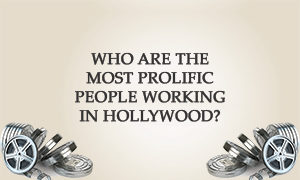 Last week, I looked at how the composition of crews on Hollywood movies has changed over the years.
Last week, I looked at how the composition of crews on Hollywood movies has changed over the years.
This piece led a few people to ask questions on related topics, one of which I will address today. John asked:”From your datasets can you see which people have worked the most often?”
To answer the question, I looked at all credits received on the 200 highest-grossing movies at the US box office between 1997 and 2016 (i.e. 4,000 movies). I then created league tables of the most frequently-credited people in a number of major roles.
Today’s research is only looking at movies, so work on other media is not being counted (i.e. TV shows).
Most prolific directors in Hollywood
Let’s start with the highest profile creative role on a movie – the director.
Over the past two decades, Woody Allen has directed 19 movies, which puts him on top, overtaking Clint Eastwood (17 directing credits), Tyler Perry (16) Steven Spielberg (15) and Steven Soderbergh (15). 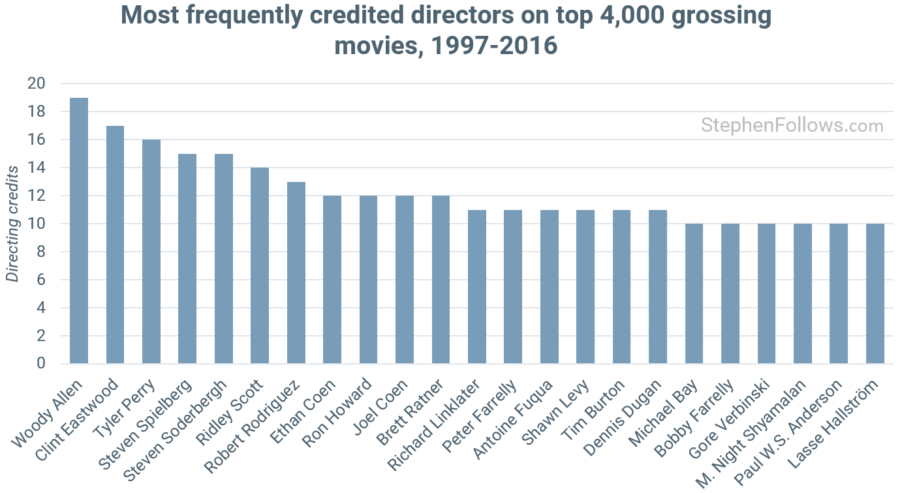 In a past study on gender in UK film, I showed how the vast majority of directors are male and that female directors have a harder time making their second, third and four films than their male counterparts.
In a past study on gender in UK film, I showed how the vast majority of directors are male and that female directors have a harder time making their second, third and four films than their male counterparts.
This could explain why out of the 139 most prolific directors (i.e. those who have shot at least six films in the two decades I studied), only five were women – Lana Wachowski, Nancy Meyers, Mira Nair, Catherine Hardwicke and Betty Thomas. Other prolific women directors include Sofia Coppola (who directed 5 films in my study), Anne Fletcher (5), Nicole Holofcener (4), Nora Ephron (4), Patricia Riggen (4) and Gurinder Chadha (4).
Most prolific producers in Hollywood
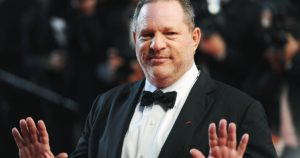 For most of the past two decades, Harvey Weinstein and his brother Bob Weinstein (145) were among the most powerful and prolific movie producers with almost 150 producing credits each. Given that their company has just gone bankrupt and Harvey is being sued or prosecuted in a number of countries, it’s clear that their names will not be in such a list in years to come.
For most of the past two decades, Harvey Weinstein and his brother Bob Weinstein (145) were among the most powerful and prolific movie producers with almost 150 producing credits each. Given that their company has just gone bankrupt and Harvey is being sued or prosecuted in a number of countries, it’s clear that their names will not be in such a list in years to come.
Other prolific film producers include Bruce Berman (producer of 88 movies over this period and chairman of Village Roadshow), Toby Emmerich (79 producing credits), Arnon Milchan (79), Ryan Kavanaugh (71), Scott Rudin (65), Tim Bevan (62), Michael Paseornek (62) and Eric Fellner (61). 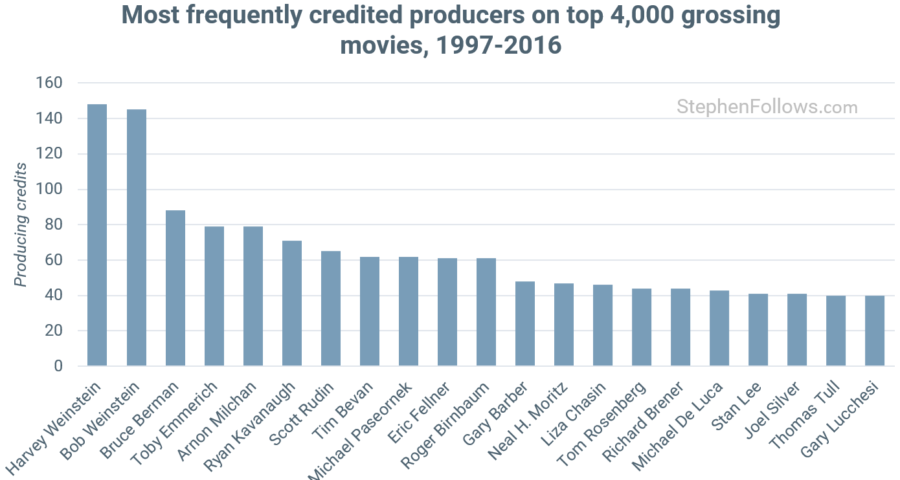 You may be surprised to see that Tim Bevan and Eric Fellner have a different number of producing credits. The pair founded and co-run the British production powerhouse Working Title, so one might have assumed that they would both be credited on all movies the company makes. And that is the case for the vast majority of their movies. Tim is credited as a producer on all 61 movies Eric has produced over this period. However, Tim has one additional producing credit not shared with Eric – High Fidelity.
You may be surprised to see that Tim Bevan and Eric Fellner have a different number of producing credits. The pair founded and co-run the British production powerhouse Working Title, so one might have assumed that they would both be credited on all movies the company makes. And that is the case for the vast majority of their movies. Tim is credited as a producer on all 61 movies Eric has produced over this period. However, Tim has one additional producing credit not shared with Eric – High Fidelity.
Most prolific writers in Hollywood
 Who tops the ‘Most Prolific Writers’ list depends on what you regard as a writing credit. For this research, I classified any credit on the movie directly related to the creation of the script as a writing credit, thereby including people who were credited for creating characters, forming storylines, etc.
Who tops the ‘Most Prolific Writers’ list depends on what you regard as a writing credit. For this research, I classified any credit on the movie directly related to the creation of the script as a writing credit, thereby including people who were credited for creating characters, forming storylines, etc.
This method results in the most prolific writer being Stan Lee, creator of many of the Marvel superheroes which are currently dominating our cinema screens. It also boosts the number two writer, Luc Besson, as it counts his work creating the story for such classics as District 13 Ultimatum, Taxi 4 and From Paris With Love. (The last of those movies has one of the best/worst taglines in movie history: “Two agents. One city. No Merci”).
If you use a stricter definition of writing to mean that they get a full writing credit, then Woody Allen again tops the list, with 19 writing credits on the movies studied. 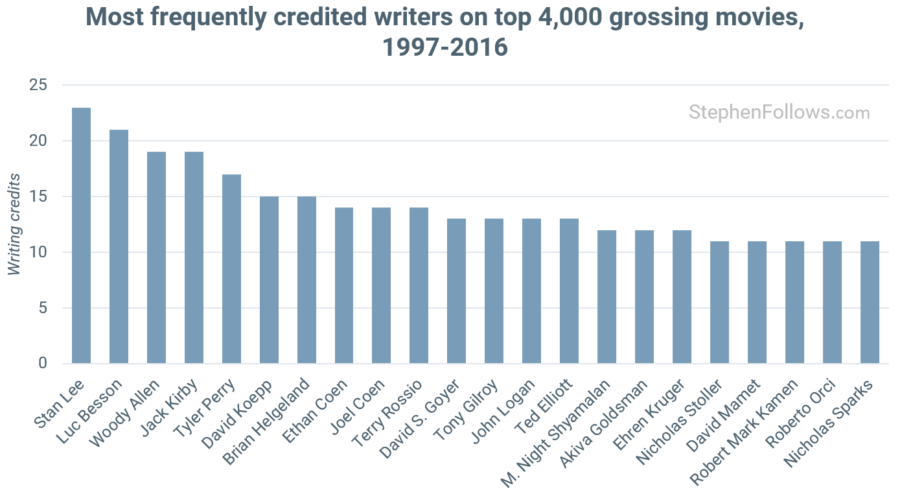
Most prolific cinematographers in Hollywood
 Earlier this month, Roger Deakins picked up his first Oscar statuette for his work on Blade Runner 2049.
Earlier this month, Roger Deakins picked up his first Oscar statuette for his work on Blade Runner 2049.
Much of the industry and the press regarded this as a long overdue honour, given the scale, breadth and quality of his work over the years. He has been nominated for the Academy Award for Best Cinematography fourteen times but this year was his first victory. The quality of his work is impressive, as is the sheer volume. He was the most prolific cinematographer in my study, shooting 29 movies, including Skyfall, A Beautiful Mind and eleven movies by the Coen brothers.
Other prolific cinematographers include Dean Semler (26 movies in the study), Robert Elswit (26), Andrew Dunn (26), Oliver Wood (24) and Don Burgess (24). 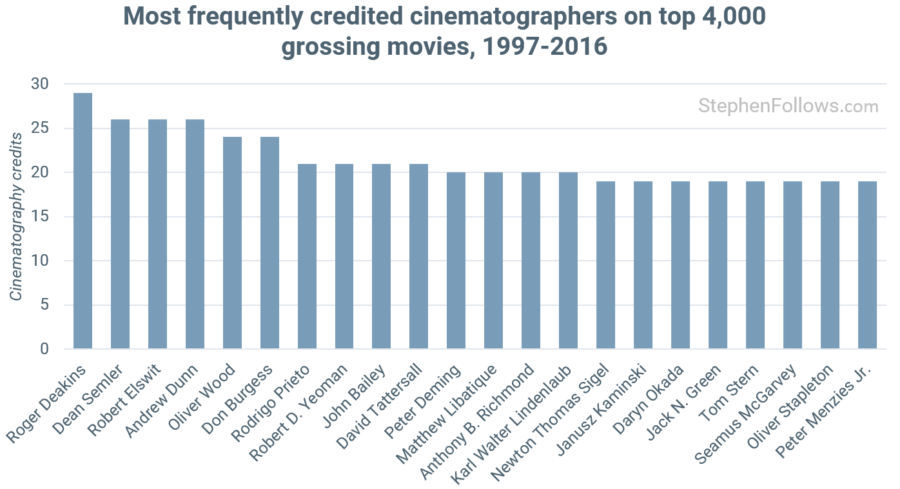
Most prolific editors in Hollywood
Tim Burton’s go-to editor Chris Lebenzon is the most prolific editor, followed by Michael Kahn (23), Pietro Scalia (22), Debra Neil-Fisher (21), William Goldenberg (21), Stephen Mirrione (20), Conrad Buff IV (20) and Peter Teschner (20). 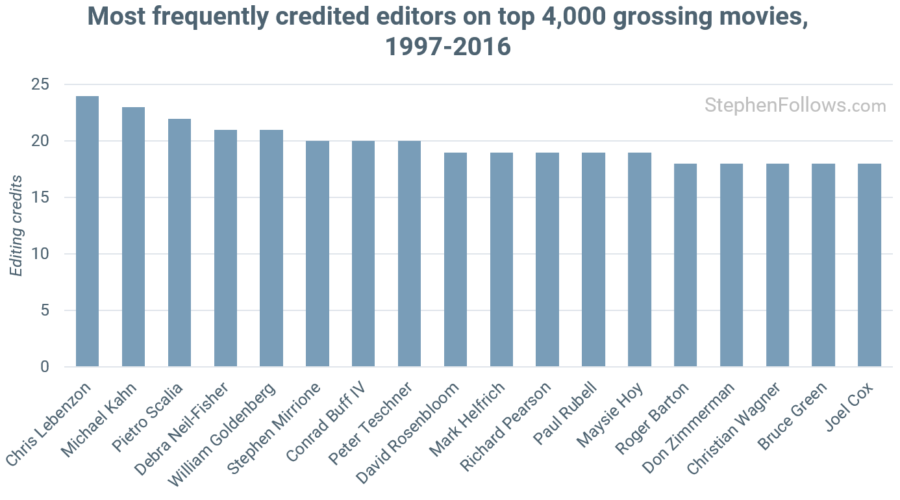
Most prolific composers in Hollywood
Christophe Beck (74) just pipped John Debney (73) to the title of most prolific composer, with 74 credits to John’s 73. Christophe has written music for a variety of movies, including Frozen, Edge of Tomorrow, Movie 43, The Hangover and Ant-Man.
They are followed by James Newton Howard (68), Hans Zimmer (65), Marco Beltrami (62), Mark Isham (56) and Danny Elfman (52). 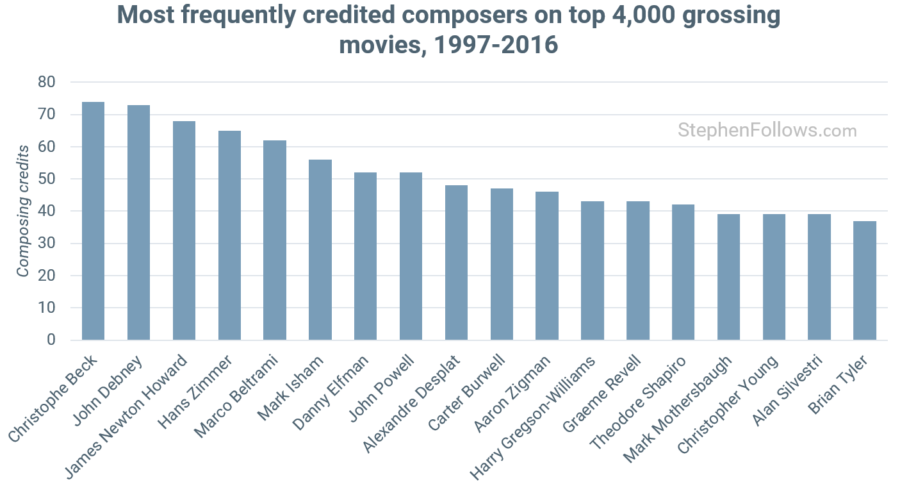
Most prolific actors in Hollywood
 Among the most frequently-credited actors are some well-known names and some less well-known supporting talent.
Among the most frequently-credited actors are some well-known names and some less well-known supporting talent.
For example, the most credited man was Greg Bronson, whose 69 roles ranged from homeless man, mailman, to madman, to name but a few. The second most credited is Samuel L. Jackson (54 credits), followed by Elton LeBlanc (53), Mark Falvo (50), Paul Giamatti (47), Joseph Oliveira (46), Frank Welker (46), Bern Collaço (45), J.K. Simmons (45) and Cynthia LeBlanc (45). 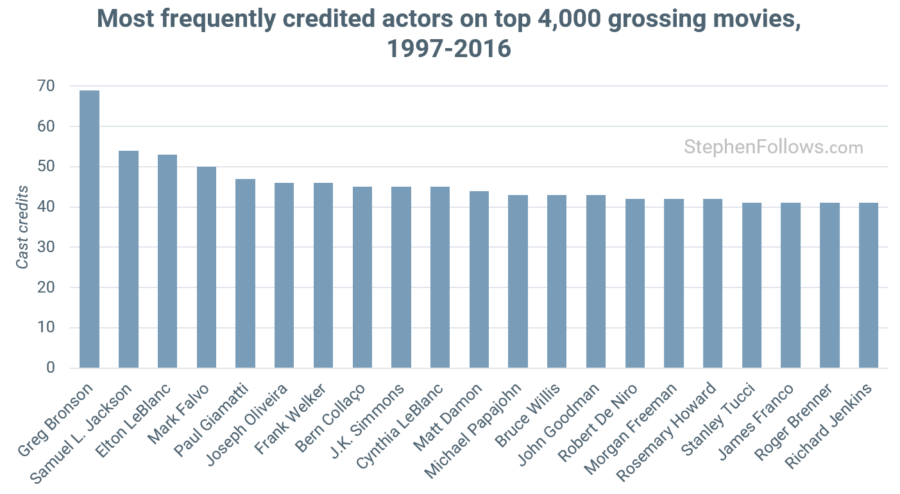
Most prolific production designers in Hollywood
The most prolific production designer in my study, Perry Andelin Blake (28), has worked on many movies starring Adam Sandler and Kevin James – both rather prolific themselves. (Adam Sandler is the 27th most prolific producer).
Other top production designers include Mark Friedberg (23 credits), Thérèse DePrez (21), Jon Gary Steele (20), Nelson Coates (20), David Gropman (20) and Rusty Smith (20). 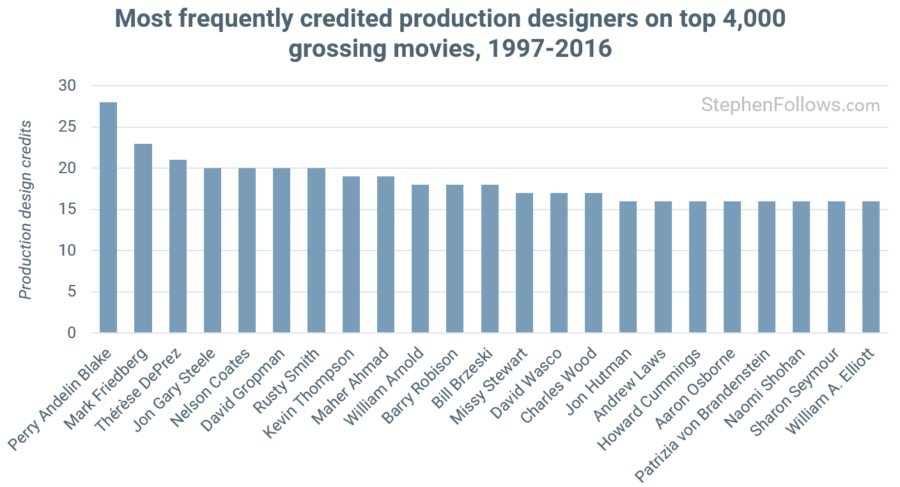
Most prolific costume designers in Hollywood
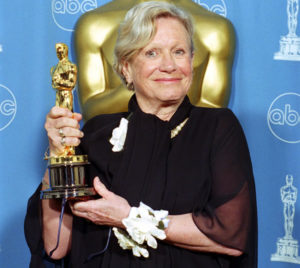 Ann Roth‘s first credit as a costume designer came in 1964 on The World of Henry Orient (a comedy in which Peter Sellars plays a ladies’ man whose life is turned upside down when two fourteen-year-old schoolgirls fall in love with him). She’s still going strong, including her recent work on Mr Popper’s Penguins (a comedy in which Jim Carrey plays a divorced man whose life is turned upside down when six Gentoo penguins fall in love with him). Ann has designed costumes for 125 film and TV productions over the years, of which 34 were in my 20-year feature film study.
Ann Roth‘s first credit as a costume designer came in 1964 on The World of Henry Orient (a comedy in which Peter Sellars plays a ladies’ man whose life is turned upside down when two fourteen-year-old schoolgirls fall in love with him). She’s still going strong, including her recent work on Mr Popper’s Penguins (a comedy in which Jim Carrey plays a divorced man whose life is turned upside down when six Gentoo penguins fall in love with him). Ann has designed costumes for 125 film and TV productions over the years, of which 34 were in my 20-year feature film study.
Other prolific costume designers include Mary Zophres (30 movies in the study), Colleen Atwood (29), Louise Frogley (28), Shay Cunliffe (26), Ruth E. Carter (25), Sanja Milkovic Hays (25) and Ellen Mirojnick (25). 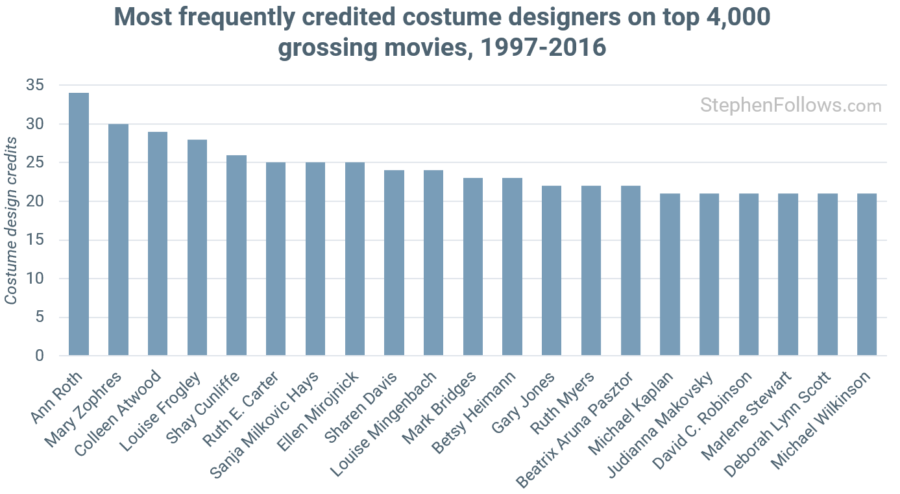
Most prolific casting directors in Hollywood
Mary Vernieu (117) has worked as a casting director on a staggering 117 movies within my dataset. If you include all her TV work and projects before and after my study period, she has 373 on-screen credits in casting-based jobs.
Other prolific casting directors include Francine Maisler (91 credits in my study), Avy Kaufman (89), Deborah Aquila (88), Tricia Wood (79), Kerry Barden (78), Jeanne McCarthy (76) and Cathy Sandrich Gelfond (76). 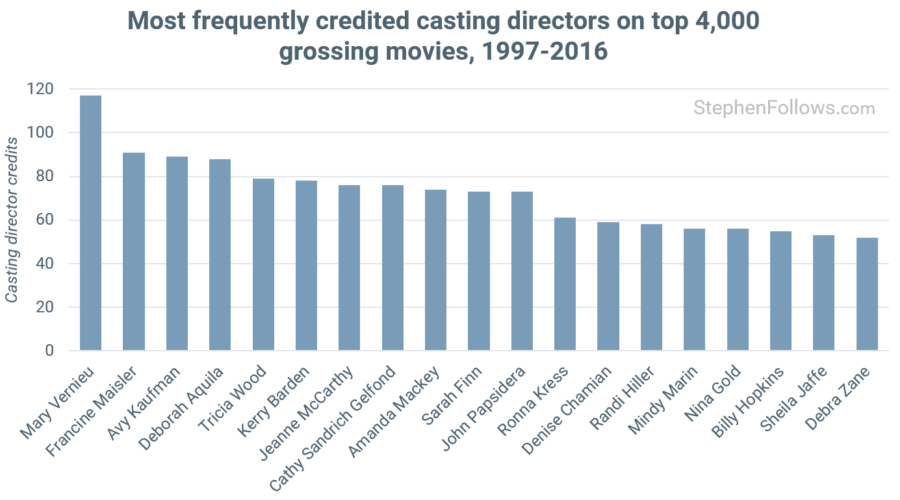
Most prolific stunt professionals in Hollywood
 Due to the fact that stunt professionals typically work on movies for short periods of time, the number of credits the top performers have managed to rack up is rather impressive. Stunt performer, driver and co-ordinator Jimmy N. Roberts is Hollywood’s most prolific stunt professional, with 133 credits in my study – an average of one every two months for past two decades.
Due to the fact that stunt professionals typically work on movies for short periods of time, the number of credits the top performers have managed to rack up is rather impressive. Stunt performer, driver and co-ordinator Jimmy N. Roberts is Hollywood’s most prolific stunt professional, with 133 credits in my study – an average of one every two months for past two decades.
He’s closely followed by Blaise Corrigan (130 credits), Joe Bucaro III (123), Peter Epstein (121), John Cenatiempo (114), Chris Palermo (113), Manny Siverio (109) and Roy Farfel (109). 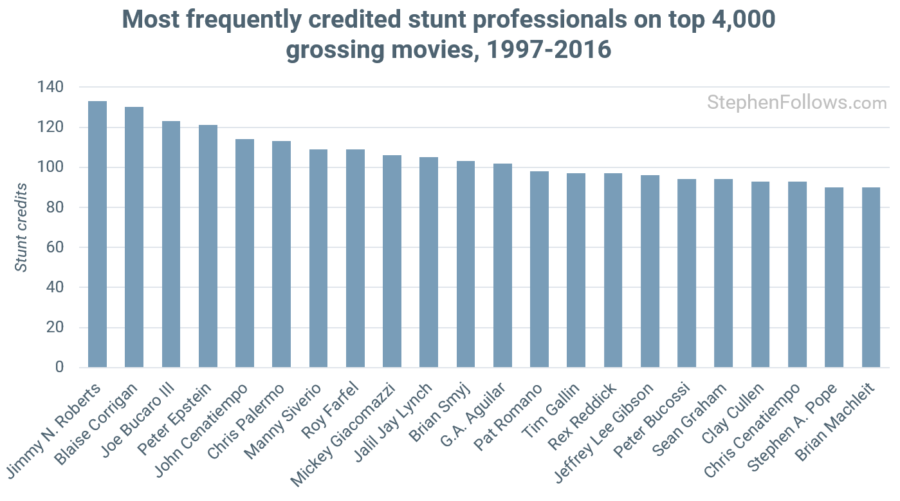
Most frequently thanked people in Hollywood
 Finally, let’s take a look at the people who are most often thanked in the credits of a movie. Over the years, Philip M. Strub has been thanked in a few different ways. He’s received 21 “special thanks”, nine “thanks” and five times the producers “gratefully acknowledged his cooperation”.
Finally, let’s take a look at the people who are most often thanked in the credits of a movie. Over the years, Philip M. Strub has been thanked in a few different ways. He’s received 21 “special thanks”, nine “thanks” and five times the producers “gratefully acknowledged his cooperation”.
What has he done to receive the most thanks Hollywood has bestowed? He is the entertainment liaison at the Department of Defense.
This means that if producers want to use US military people, buildings or equipment then they have to get Philip on-side first. He initially refused Pentagon support for the producers of Man of Steel as he found the script’s portrayal of the US Army to be”cartoony”. According to Fortune magazine: “Warner Bros. asked Strub to reconsider, flying him to L.A. to meet screenwriter David S. Goyer, who modified his script to incorporate Strub’s suggestions”. As well as authentic props and impressive locations, the US military can also provide very cheap extras as enlisted men and women are not covered by union rates of pay.
Other often thanked people include Katherine Oliver (Commissioner of New York’s Mayor’s Office of Film, Theatre, Broadcasting), Michael Bloomberg (New York’s three-time mayor), John Hadity (film finance expert) and James Alexander Waller (previously head of the Met Police’s Film Office and currently London’s Film Commissioner). 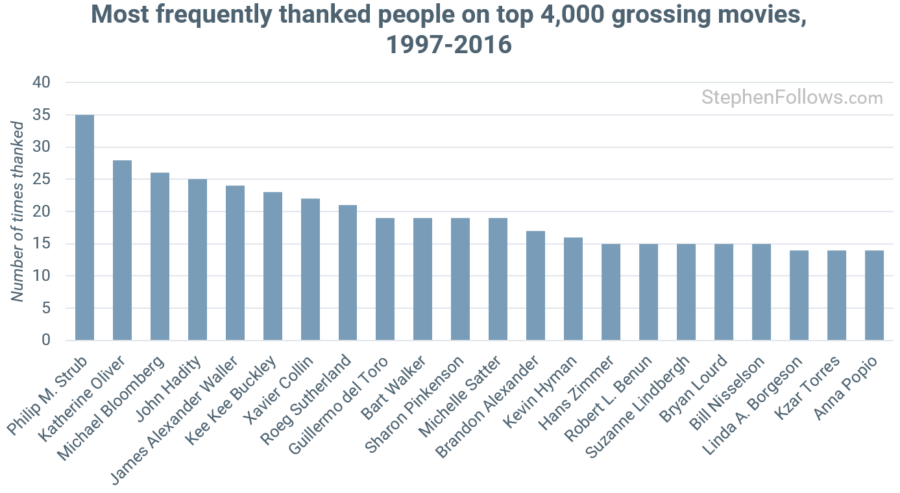 If this topic interested you then may want to refer to a couple of articles I published four years ago looking at the UK film industry: The most employed people in the British film industry, and the most employed women in the British film industry.
If this topic interested you then may want to refer to a couple of articles I published four years ago looking at the UK film industry: The most employed people in the British film industry, and the most employed women in the British film industry.
Data
The data for today’s research came from IMDb, Wikipedia and The Numbers.
I have used the US box office as the criteria because the numbers are more reliable (and complete) than that of the worldwide box office. I focused on the top 200 grossing films, rather than all films made or all films released, in order to be able to compare like with like.
This research focuses on credits received, not seniority or time served. That means that someone who worked on a production for just one day counts the same as someone who was on the production for months. It’s also worth reiterating that I was just looking at movies. This means that someone could have a very prolific career within TV, music videos, adverts, etc and yet not rank too highly within today’s charts.
Epilogue
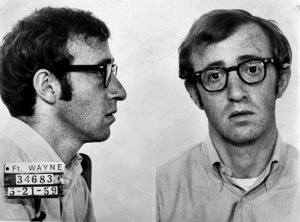 It’s interesting that some of the top people seem to personify the very best and worst sides of Hollywood.
It’s interesting that some of the top people seem to personify the very best and worst sides of Hollywood.
The top director and producer (Allen and Weinstein) have both been accused of abusing power to sate their own sadistic sexual proclivities, the person who most appears behind the scenes arranging things is employed by the US Army to help with promotion/ propaganda and the most-credited performer frequently played roles with a variation on ‘crazy man shouting at people’.
On the other side, the hardest-working creatives are often among the most talented and it’s inspiring to see how broad and diverse some of their filmographies are.

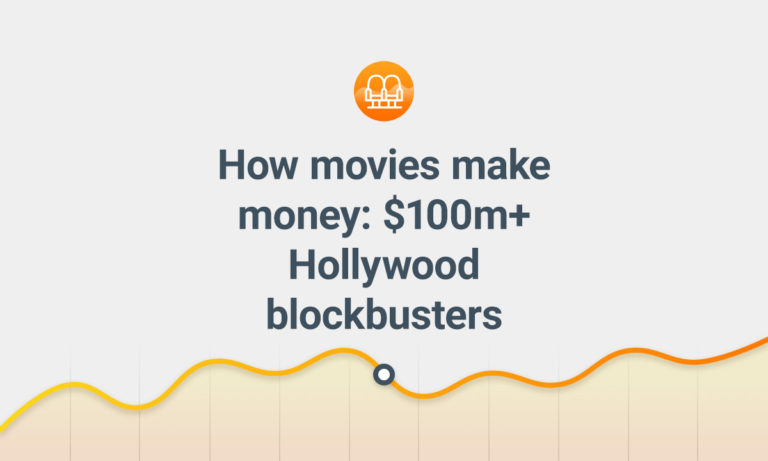
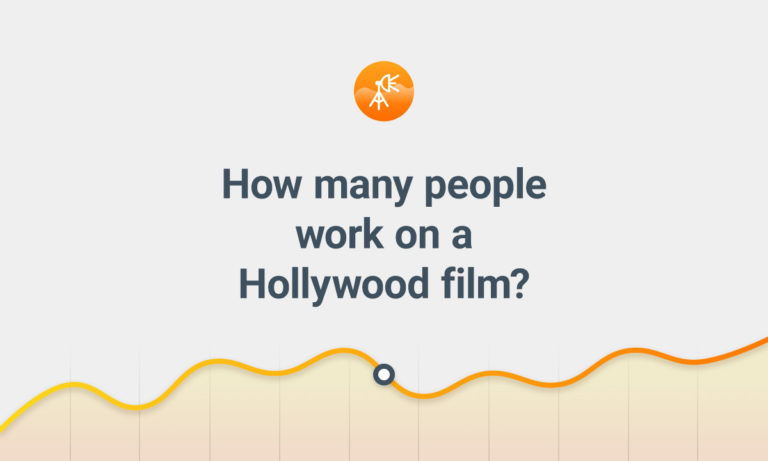
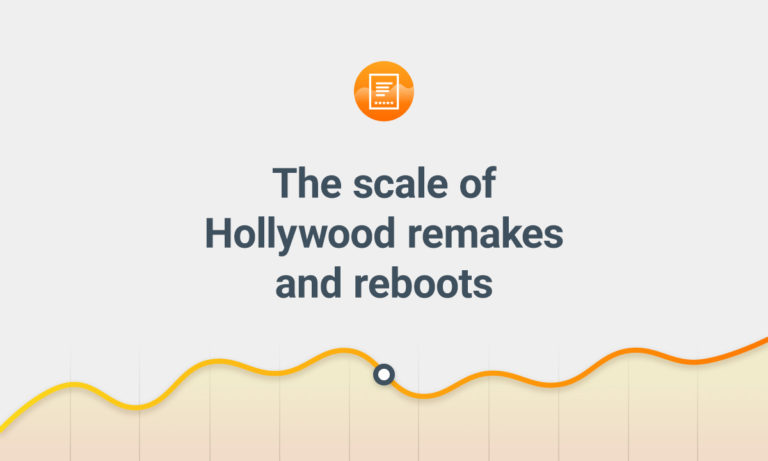

Comments
Thanks, Stephen – As always, the analysis is fascinating and I very much enjoyed the final summary.
It’s amazing how you did this analysis, combing through tons of credits over 4000 movies. I’m wondering how long did it take to produce this study?
Thanks again. Brilliant work.
Bravo on another excellent analysis.
I hope it’s okay to point or that only FOUR of the 139 directors you mentioned are female, not five. Female is a specific biological designation based upon DNA (chromosomes, gonads, etc). Although Lana Wachowski identifies and lives as a woman, she is a biologically male woman. You could have said five directors are women.
Then again, even that is problematic. Can we really claim a director who established themselves professionally, working the studio system and building a career using their male presentation, as representative of a woman’s trajectory through the industry? The body of work through which she acquired industry power predates her transition and her career circumvented the issues that are barriers to women.
This is not to question Wachowski’s identity or status. I appreciate that the intent is to be respectful and inclusive, which I wholly appreciate – especially coming from the author of the hugely valuable UK gender study back in 2016. However, including Lana without further explanation amounts to a 20% over-representation in your data of what the system has permitted women to achieve. That’s a massive skew, of huge statistical significance. If we want to accurately analyse the impact of gender, and of sex discrimination, we need to acknowledge that people who have established careers presenting as their initially assigned gender experience different limitations to the gender to which they then transition. For accuracy’s sake, it must be recorded that such data comes from a distinct (trans) category.
You’re absolutely right. It was sloppy language on my part and I’ve updated the article.
This topic came up when I was working on my gender study of UK film a few years ago. As the Wachowski’s often shoot films in the UK and so they show up on the list of directors of UK films. For me, the topic highlighted the many reasons why gender inequality is a problem. In that case, we were looking at how directors get their start, and so Lana’s transition from a man to a woman meant that her early career journey could theoretically have been different from that of a director who was a woman from the outset. Whereas if we are more focused on the male gaze affecting the current movie output, then perhaps her previous gender identity has less relevance.
I am no expert on this particular topic and so it’s awesome to have engaged readers who can add their thoughts and point out where I could tweak my outlook and writing. Thanks, Tiggy!
Thanks so much for the thoughtful response!
I count 10 for Bigelow.
In the research criteria (top 200 US grossing movies released between 1997 and 2016) she directed three movies – The Hurt Locker, Zero Dark Thirty and K-19: The Widowmaker.
I’m not sure which ten you’re referring to but the other seven must be outside this criteria. Some are likely too old (i.e. Point Break), more recent (Detroit), short films (i.e. Mission Zero), TV (i.e. Homicide: Life on the Street) or not grossed enough (i.e. The Weight of Water).